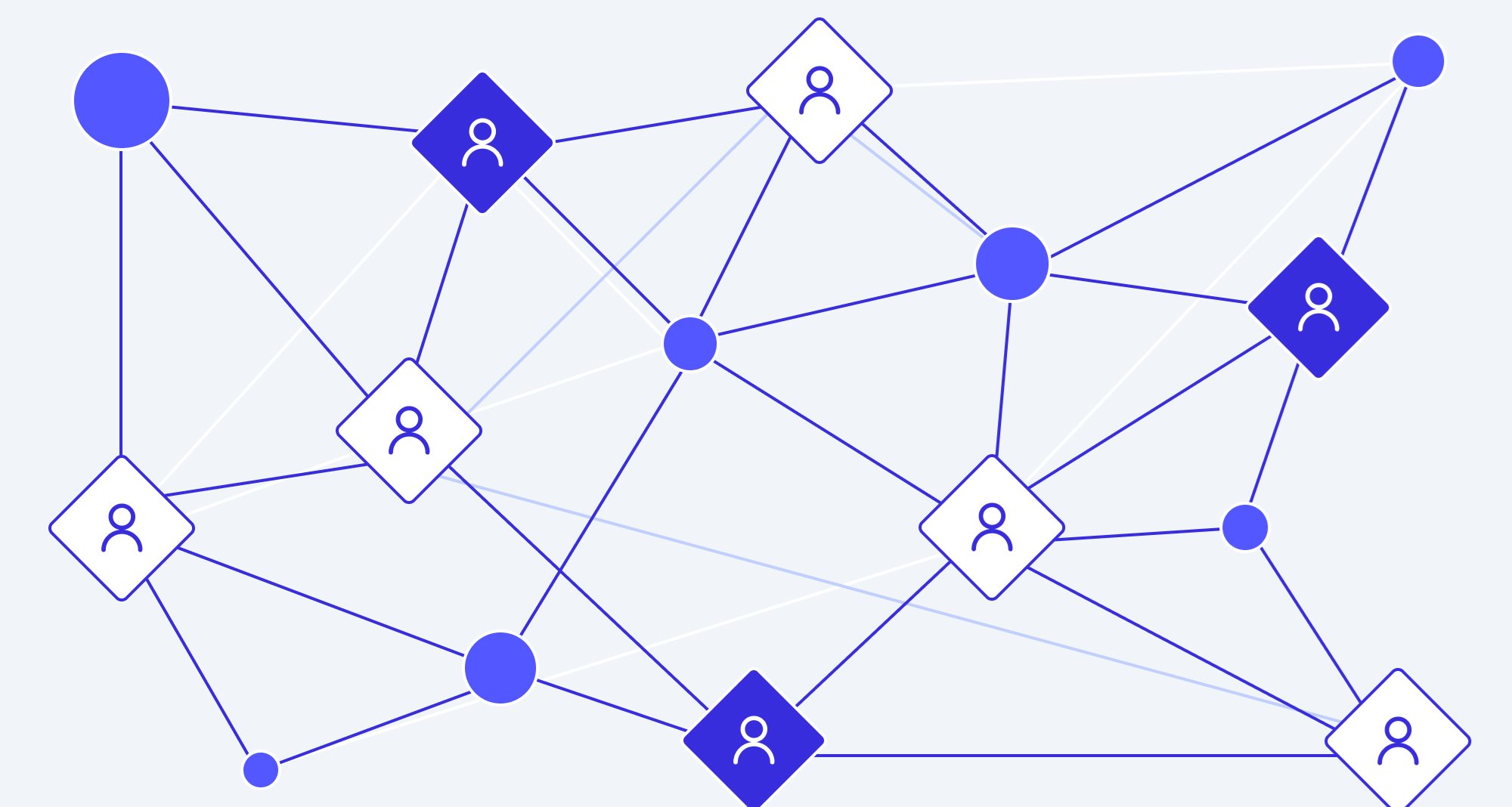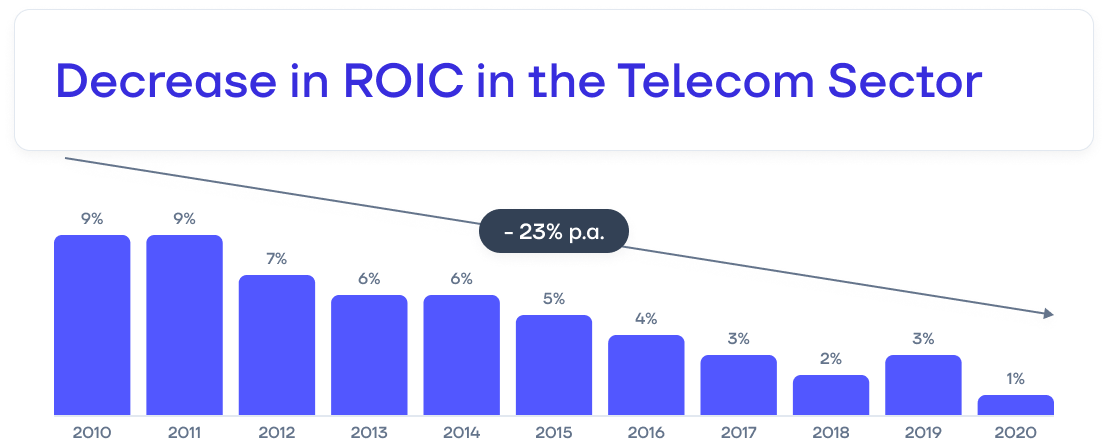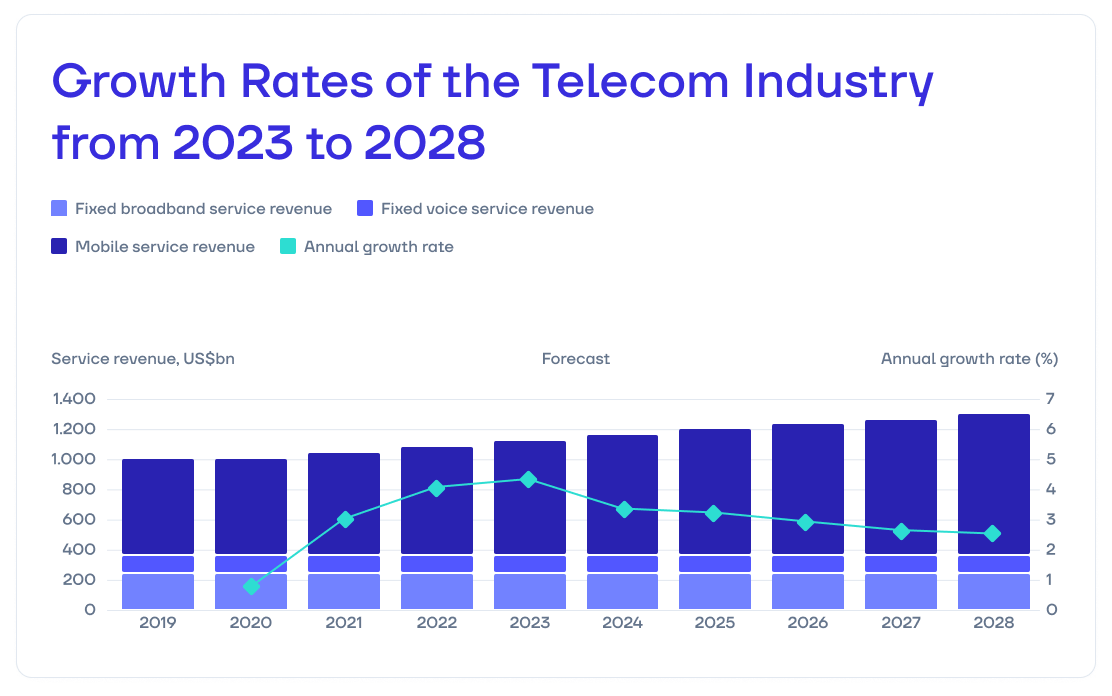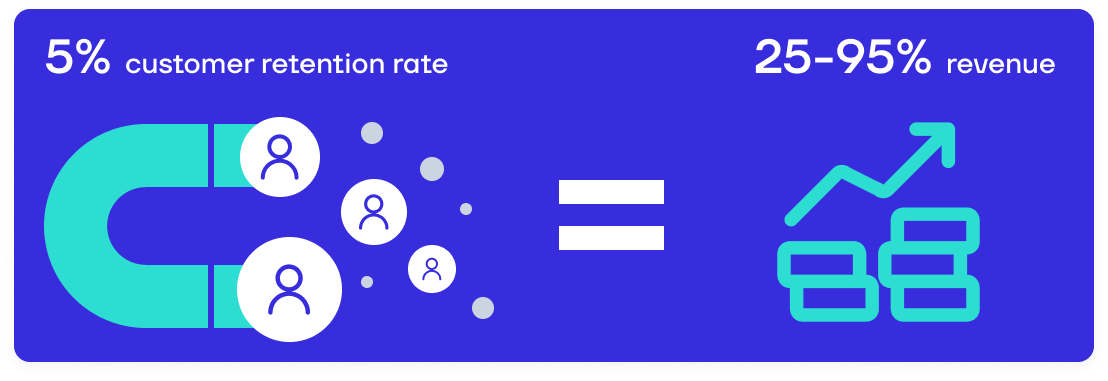Marketing Challenges in Telecommunications 2025: How Technology Helps Overcome Industry Hurdles

How the Telecom Market Has Changed Over the Past 10 Years
With the rapid advancement of technology, the mobile communications market has reached a saturation point. Profit growth and ROI have slowed. Let’s take a look at how this shift is affecting the business landscape—and how telecom marketing has evolved by 2025 as a result.
Declining Profitability and Intense Competition
A decade ago, mobile operators were seeing annual revenue increase of 10–20% simply by expanding their subscriber base. By 2025, however, things look very different. According to McKinsey, marketing efficiency in the telecom industry is on the decline. An annual revenue growth across global telecom operators has been steadily decreasing and now hovers around just 2%.
Another major issue: operators are pouring massive investments into network infrastructure and 5G development, but these costs are barely recouped. Fierce market competition and strict regulatory limits prevent companies from raising prices to even minimally profitable levels. As a result, telecom marketing is facing problems with ROI.

Operators’ Return on Invested Capital (ROIC) continues to decline.
Source: How telcos can succeed in launching new businesses beyond connectivity (McKinsey)
The inability to raise service prices due to competition and regulatory constraints is only one factor behind the telecom industry’s declining performance. The second—and equally critical—is the decreasing effectiveness and the traditional telco marketing strategy crisis. Why is this happening, and how can operators find new ways to retain customers and boost revenue? Let’s explore.
The Telecom Marketing Crisis 2025: Why Customers Are Leaving and ARPU Isn’t Growing
The telecom services market faces saturation problems, making it increasingly difficult to attract new subscribers. In response, operators have shifted their focus to boosting ARPU (Average Revenue Per User). But even these efforts are falling short. In developed countries, ARPU is already on the decline and, according to PwC, is projected to keep dropping at an average annual rate of –1.3% through at least 2028.
Since 2023, the overall growth rate of the industry has also been slowing alongside ARPU. The result is that business models that once reliably generated revenue are no longer delivering.

The average annual profit growth rate in the telecom industry has been declining since 2023.
Source: Perspectives from the Global Telecom Outlook 2024-2028 (PWC)
One of the key reasons for declining revenue is outdated customer communication strategies, in particular mass marketing inefficiency in telecom. For years, marketers relied on mass messaging and campaigns based on basic manual analysis of the subscriber base or customer surveys. By 2025, traditional campaign effectiveness declined: non-personalized offers not only fail to drive purchases—they actively frustrate subscribers. Receiving irrelevant promotions is now one of the top two drivers of customer churn.
Today, telecom customer behavior is changing. Users expect a personalized experience. The reason is simple: they’re getting similar services from multiple operators, so their choice is no longer based on price alone—it’s also about the quality of service. If the customer experience falls short of expectations, switching providers is easy. Subscriber churn has become a significant challenge in telecom marketing.
Yet retaining an existing customer is 25 times more cost-effective than acquiring a new one (CAC), and it delivers greater long-term value by increasing LTV.

Even a 5% increase in customer retention can lead to a profit boost of anywhere from 25% to 95%.
Source: Five Strategies To Improve Customer Retention (Forbes)
To stay competitive, operators need to fundamentally rethink how they communicate with their audience. A higher level of service is impossible without personalization—it’s essential to take into account each subscriber’s behavior, interests, and context. Customer engagement challenges are emerging for telecom.
But with millions of users, manual data handling simply isn’t feasible. That’s why traditional tools are being replaced by automated platforms that enable real-time audience segmentation and personalized, omnichannel communication at scale.
The Marketing Automation Issues in Telecommunications
By 2025, the primary tool for telecom marketing automation is the campaign manager. It frees operator teams from routine tasks, accelerates workflows, and enables them to:
- Precisely segment target audiences
- Flexibly manage contact policies
- Respond quickly to shifting customer needs
- Launch more campaigns simultaneously—and do it faster
- Test hypotheses and rapidly scale what works
But a campaign manager is just one piece of effective marketing. To make a real impact on incremental revenue, ARPU and LTV operators must analyze customer data and respond to user actions and events. This is where analytics and trigger platforms come into play:
- A trigger platform allows for real-time audience segmentation and helps identify the optimal moment to launch a campaign
- An analytics platform builds 360° subscriber profiles and predicts behavior, enabling a deeper understanding of the audience and more relevant offers
All three areas of marketing automation are covered by the EW Marketing Platform CVM solution. It creates a synergistic effect by centralizing data processing and automatically feeding insights into other systems for marketing use. As a result, staff workload and time costs are reduced, while targeting accuracy and campaign conversion rates significantly increase.
We’ve seen the telecom market evolve first hand over the past few years. A decade ago, CVM solutions seemed like a luxury reserved for major players—but today, marketing automation is essential.
Consumers have become much more demanding when it comes to service. They expect operators not just to meet their needs, but to anticipate them. That’s where a comprehensive CVM solution comes in. It enables businesses to truly understand their audience, predict behavior, and stay one step ahead of customer expectations.
This approach helps companies boost subscriber loyalty and ARPU, reduce churn, and ultimately grow their incremental revenue.
Roman Vasiliev,
Chief Commercial Officer, Eastwind
Learn More About the EW Marketing Platform
How to Solve Telecom Marketing Challenges in 2025
New challenges call for new solutions. Let’s look at how the transformation trends are reshaping telecom marketing and how automation through a CVM platform helps telecom operators address today’s business demands.
Challenge—Manual Work Slows Everything Down. To keep pace with their subscribers, operators need to constantly collect analytics and make real-time adjustments to campaigns. Doing this manually is not only slow—it’s error-prone. For example, launching a single campaign often requires a long chain of routine tasks: a BI analyst manually selects the audience, compiles reports, and hands them over to the marketing team. The marketer then exports campaign reports, analyzes the results, adjusts message parameters, and sends out offers based on the BI team’s selection.
This process not only diverts team resources away from strategic priorities but also limits the ability to quickly optimize campaigns based on performance insights.
Solution—Automate Campaign Management. A campaign manager minimizes errors and enables teams to launch new initiatives in minutes. For instance, in the EW AdTarget, all routine operations are automated: The system generates reports, displays key metrics on dashboards, and allows users to update campaign parameters with just a few clicks. Thanks to ready-made templates and a no-code builder, marketers can quickly launch and tweak campaigns on their own.
Automation is the defining telecom marketing transformation trend for 2025—and it’s the key to speed, precision, and scale.

18% of senior executives in the telecom industry view automation as the key to improving efficiency.
Source: The future of telcos: Mapping the routes to renewed success (McKinsey)
Learn More About the Capabilities of the EW AdTarget
Challenge—Shallow Segmentation Misses the Mark. The information collected from a subscriber at the time of SIM card purchase—typically via a simple form—only scratches the surface. Critical data points, such as social connections, frequently visited websites, geolocation, services used, and even the actual SIM card user often remain hidden. Without these insights, subscriber profiles remain incomplete, and operators miss opportunities to boost ARPU through relevant upsells and personalized service offerings.
Solution—Build Deep Subscriber Profiles. To truly understand customers, operators need to leverage behavioral analytics powered by big data platforms. These technologies solve telecom segmentation challenges by collecting and processing data from multiple sources and enabling the use of machine learning models to predict customer behavior and build comprehensive 360° profiles.
For example, the EW DataFlow platform supports the deployment of advanced analytics models for subscriber profiling and churn prediction. This deeper insight into user behavior allows operators to deliver more targeted, relevant offers—ultimately driving higher engagement and revenue.

58% of executives across banking, retail, telecom, and other tech-driven industries have reported positive results from using data analytics
Source: Real-Time Analytics (Harvard Business Review)
Learn More About the Capabilities of the EW DataFlow
Challenge—Poor Timing Undermines Advertising Effectiveness. Timeliness is a crucial element of personalized offers. Conversion rates are significantly higher when a subscriber actually needs the service being promoted. For instance, if a user runs out of data and still has sufficient balance to purchase a one-time package, they’re far more likely to accept the offer at that exact moment than at any other time.
Solution—Use Triggers. Modern trigger-based platforms, such as the EW Event Processing, help identify and act on the optimal moment to deliver a message. The system continuously monitors user activity—like remaining data and account balance—and as soon as it detects that the subscriber is out of data and has enough funds, it automatically sends a command to the campaign manager to push a relevant internet add-on offer.
This kind of real-time, context-aware engagement ensures that offers are not only personalized, but also perfectly timed—maximizing both user satisfaction and conversion rates.

60% of executives in banking, retail, telecom, and other tech-driven industries consider real-time marketing critically important for customer experience (CX)
Source: Real-Time Analytics (Harvard Business Review)
Challenge—Fragmented Data Sources and Communication Channels. Fragmentation is a major hurdle for telecom operators, and it shows up in two critical areas.
Firstly, disconnected Data Systems Customer data is scattered across various platforms: service usage in billing systems, support history in CRM, app activity in web analytics tools. Without a unified infrastructure for collecting and processing this information, it's impossible to build a complete, up-to-date picture of the customer and their needs. As a result, attempts of telecom marketing automation are facing failure in telecom.
Secondly, siloed Communication Channels Marketing channels often operate independently. As a result, subscribers may receive duplicate or even conflicting offers via SMS, push notifications, and in-app banners. This lack of coordination disrupts the customer experience and weakens engagement with marketing messages.
Solution—Implement an Integrated Marketing Ecosystem. The EW Marketing Platform solves both sides of the fragmentation issue by centralizing marketing data and communication channels.
The EW DataFlow analytics module automatically collects and processes data from all systems, building real-time subscriber profiles and feeding them into the campaign manager.
The EW AdTarget uses these profiles to target the right users and selects the most effective communication channel for each individual. For example, if a subscriber regularly uses the app, the platform sends a push notification; if not, it defaults to SMS.
This seamless integration ensures consistent, relevant communication—without the need for manual data transfers between systems. The result is a more coherent customer journey, higher responsiveness to offers, and greater marketing efficiency.

According to estimates by South Korean mobile operator SK Telecom, up to 30%
of operational costs can be reduced through the use of AI in marketing
Source: The Mobile Economy 2024, GSMA
Case Study. A mobile operator in Central Asia deployed the full suite of the EW Marketing Platform to promote its music streaming service. The operator segmented its audience using the EW DataFlow, set up real-time triggers through the EW Event Processing, and launched the campaign with the EW AdTarget.
Results Achieved:
- 330,000 new subscribers to the music service in just six months
- 40% response rate to a USSD message
- 5% response rate from the total subscriber base—an exceptionally high result for mass-market telecom campaigns
Find Out How the EW Marketing Platform Can Solve Your Business Challenges
Key Telecom Marketing Transformation Trends in 2025
In the face of fierce competition, ad fatigue, and low customer loyalty, traditional marketing tools are no longer up to the task in 2025. Generic SMS messages sent at the wrong time are, at best, ignored—and at worst, frustrate subscribers and drive them toward more customer-centric competitors.
To remain competitive, telecom operators must transform their marketing processes. This transformation begins with a clear understanding of where things stand today: What’s missing? What’s holding back performance? And what can be done to fix it?
We’ve put together a checklist to help you self-assess your current marketing tools and see how well they align with the demands of the modern telecom market.
Self-Assessment Checklist
The questions below will help you determine whether your current marketing tools align with industry trends. If you leave more than half the boxes unchecked, it may be time to rethink your approach—your existing system might not be keeping pace with today’s market demands.
| Target Audience | Campaign Effectiveness | Campaign Management |
| Do you know the following about your subscribers: |
Do you evaluate: | How convenient and flexible are your processes: |
| the actual gender and age (not from a registration form) |
the number of opened marketing messages |
you can launch a campaign in just a few minutes |
| network of contacts | the campaign conversion rate | you can adjust the parameters of ongoing campaigns |
| interests (websites visited, call activity) | the campaign ROI (Return on Investment) |
a single marketer can manage multiple campaigns simultaneously |
| geolocation and frequently visited places |
the most effective communication channels |
campaign management doesn’t require specialized technical skills from the marketer |
| preferred communication channels | the difference in ARPU between the target group and the control group |
|
| level of satisfaction with services |
Discover how the EW Marketing Platform helps overcome market challenges by automating your marketing efforts
